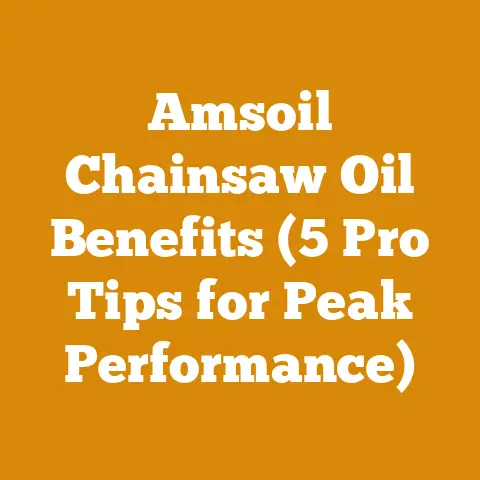Gas Motor with Hydraulic Pump (Tandem Setup Tips for Woodcutters)
Ever felt like your wood splitter was just wheezing instead of roaring through those tough oak rounds?
Or perhaps you’re dreaming of a hydraulic wood processor that can keep up with your ambitions, but the price tag is scarier than a timber rattlesnake in your boot?
That’s where understanding the power (and the potential pitfalls) of a gas motor with a tandem hydraulic pump setup comes in.
I’ve spent years wrestling with logs, building my own equipment, and learning the hard way what works and what doesn’t.
Let me share what I know about harnessing the raw power of a tandem hydraulic pump system, so you can split wood like a pro, build your dream machine, and avoid the expensive mistakes I’ve already made.
Unleashing Hydraulic Horsepower: Tandem Pump Setups for Woodcutters
The allure of a powerful wood splitter, or a custom-built log processor, is undeniable.
At the heart of these machines lies the hydraulic system, and for those seeking serious performance, a tandem pump setup is often the answer.
But before you dive in headfirst, let’s break down what a tandem pump is, how it works, and the crucial considerations for a successful build.
What is a Tandem Hydraulic Pump?
Simply put, a tandem hydraulic pump is two (or sometimes more) hydraulic pumps mechanically linked together and driven by a single input shaft, typically powered by a gas engine.
This allows you to deliver fluid at two different flow rates and pressures simultaneously.
Think of it like having two separate hydraulic systems working in harmony, powered by one engine.
Why Choose a Tandem Pump for Wood Processing?
The advantages of a tandem pump in wood processing are significant:
- Speed and Power: One pump can deliver high flow at low pressure for rapid cylinder movement (think fast retraction of your splitter wedge), while the other delivers high pressure at lower flow for splitting those stubborn knots.
This translates to faster cycle times and the ability to handle larger, tougher logs. - Efficiency: By matching the flow and pressure to the task, you can optimize engine load and fuel consumption.
No more wasting power on unnecessary pressure when you just need speed. - Versatility: Tandem pumps open the door to more complex hydraulic circuits, allowing you to power multiple functions simultaneously – for example, a log lift and a splitter.
This is crucial for building efficient log processors.
Personalized Story: My First Tandem Pump Misadventure
I remember the first time I tried to build a wood splitter with a tandem pump.
I was so excited about the potential power that I completely skipped the crucial step of understanding the pump’s specifications.
I slapped a random tandem pump onto a gas engine, hooked up the hoses, and… nothing.
Or rather, almost nothing.
The splitter moved like a snail, and the engine was screaming.
Turns out, I had mismatched the pump’s flow rates and pressure ratings to the cylinder size and the engine’s power.
It was a costly and frustrating lesson, but one I never forgot.
This is why I’m emphasizing the importance of understanding the technical details before you start wrenching.
Understanding the Technical Specifications
Before you even think about buying a tandem pump, you need to understand the key specifications and how they relate to your specific application.
This is where the rubber meets the road, and where many projects either succeed or fail.
Flow Rate (GPM or LPM)
Flow rate, measured in gallons per minute (GPM) in the US or liters per minute (LPM) elsewhere, determines the speed of your hydraulic cylinder.
A higher flow rate means faster cylinder movement.
Tandem pumps will have two separate flow rate specifications, one for each pump section.
- Data Point: A typical wood splitter might require a flow rate of 10-15 GPM (38-57 LPM) for the main cylinder to achieve a reasonable splitting cycle time.
- Insight: When choosing your pumps, consider the cylinder volume.
A larger cylinder will require a higher flow rate to achieve the same speed. - Example: If you have a 4-inch diameter cylinder with a 24-inch stroke, it has a volume of approximately 301.6 cubic inches (πr²h = π(2²)(24)).
To cycle this cylinder in 10 seconds, you would need a flow rate of approximately 7.8 GPM (301.6 cubic inches / 10 seconds = 30.16 cubic inches per second.
30.16 cubic inches per second * 60 seconds/minute / 231 cubic inches/gallon = 7.8 GPM).
Pressure Rating (PSI or Bar)
Pressure rating, measured in pounds per square inch (PSI) or bar, determines the force your hydraulic system can generate.
A higher pressure rating means you can split tougher logs.
Again, tandem pumps will have separate pressure ratings for each section.
- Data Point: A typical wood splitter might require a pressure of 2500-3000 PSI (172-207 bar) to split most types of wood.
Hardwoods like oak and maple will require higher pressures than softwoods like pine or fir. - Insight: Don’t exceed the pressure rating of any component in your hydraulic system, including the pump, cylinders, hoses, and valves.
Doing so can lead to catastrophic failure and potential injury. - Example: A 4-inch diameter cylinder operating at 3000 PSI can generate a force of approximately 37,699 lbs (πr²P = π(2²)(3000)).
This is more than enough force to split most logs, but extremely knotty or dense wood may require higher pressure or a larger cylinder.
Engine Horsepower (HP)
Your gas engine needs to be powerful enough to drive both pump sections simultaneously at their rated flow and pressure.
Insufficient horsepower will lead to sluggish performance and potential engine damage.
- Rule of Thumb: A general rule is that you need approximately 5 HP per 10 GPM of hydraulic flow at 2500 PSI.
This is just a guideline; the actual horsepower requirement will depend on the specific pump characteristics and operating conditions. - Calculation: To calculate the required horsepower, use the following formula: HP = (GPM x PSI) / 1714.
Add a safety factor of 15-20% to account for inefficiencies and peak loads.
So, for a tandem pump with sections rated at 10 GPM @ 2500 PSI and 5 GPM @ 3000 PSI, the total horsepower requirement would be: ((10 x 2500) / 1714) + ((5 x 3000) / 1714) = 14.59 + 8.75 = 23.34 HP.
Adding a 20% safety factor, you’d need an engine capable of delivering at least 28 HP. - Caution: Overpowering the pump can also be detrimental, potentially leading to overheating and premature wear.
Pump Type (Gear, Piston, Vane)
Hydraulic pumps come in various types, each with its own advantages and disadvantages.
For wood processing applications, gear pumps are the most common due to their simplicity and cost-effectiveness.
Piston pumps offer higher efficiency and pressure capabilities but are more expensive and complex.
Vane pumps are less common but can be a good compromise between gear and piston pumps.
- Gear Pumps: Robust, inexpensive, and readily available.
They are less efficient than piston pumps, typically around 80-85%. - Piston Pumps: High efficiency (90-95%), capable of generating very high pressures, and offer precise control.
However, they are more expensive and sensitive to contamination. - Vane Pumps: A good compromise between gear and piston pumps, offering moderate efficiency and pressure capabilities at a reasonable cost.
Shaft Size and Rotation
Ensure the pump shaft size and rotation direction are compatible with your gas engine.
Most small gas engines have a standard shaft size (typically 1 inch or 3/4 inch), but it’s crucial to verify.
The pump rotation direction (clockwise or counterclockwise) must also match the engine’s rotation.
- Tip: If you’re unsure about the engine’s rotation direction, consult the engine’s manual or look for an arrow on the engine’s flywheel.
Mounting Configuration
The pump must be securely mounted to the engine.
Most tandem pumps have a standard SAE mounting flange.
Make sure the engine has a compatible mounting surface.
- Warning: Improper mounting can lead to vibration, noise, and premature pump failure.
Oil Type and Filtration
Using the correct hydraulic oil and maintaining proper filtration are crucial for the longevity of your hydraulic system.
Consult the pump manufacturer’s recommendations for the appropriate oil type and viscosity.
A good quality hydraulic filter is essential to remove contaminants that can damage the pump and other components.
- Data Point: Most hydraulic systems used in wood processing applications use ISO 46 or ISO 68 hydraulic oil.
- Insight: Change the hydraulic oil and filter regularly, especially during the initial break-in period.
Designing Your Hydraulic Circuit
Once you understand the pump’s specifications, you need to design a hydraulic circuit that utilizes the tandem pump’s capabilities effectively.
This involves selecting the appropriate valves, cylinders, hoses, and fittings.
Valve Selection
The valves control the direction and flow of hydraulic fluid.
For a wood splitter, you’ll need a directional control valve to extend and retract the cylinder.
For more complex log processors, you might need additional valves to control other functions, such as a log lift or a log grapple.
- Open Center vs.
Closed Center Valves: Open center valves allow fluid to flow through them when they are in the neutral position.
Closed center valves block the flow in the neutral position.
Tandem pumps are typically used with open center systems, as they can continuously deliver fluid without building up excessive pressure when no functions are activated. - Valve Flow Rating: Ensure the valve’s flow rating is adequate for the pump’s flow rate.
A valve that is too small will restrict the flow and reduce the system’s performance.
Cylinder Sizing
The cylinder size determines the force and speed of the hydraulic movement.
As mentioned earlier, a larger cylinder will generate more force but will also require a higher flow rate to achieve the same speed.
- Cylinder Bore and Stroke: The bore (diameter) of the cylinder determines the force, while the stroke (length) determines the distance of travel.
- Tie Rod vs.
Welded Cylinders: Tie rod cylinders are easier to repair, while welded cylinders are generally more robust.
Hose and Fitting Selection
Use high-quality hydraulic hoses and fittings that are rated for the system’s maximum pressure.
Ensure the hose size is adequate for the pump’s flow rate to minimize pressure drop.
- Hose Size: Use a hose size that is at least as large as the pump’s outlet ports.
- Fitting Type: Use JIC (37-degree flare) fittings, as they are reliable and easy to assemble.
Hydraulic Tank Sizing
The hydraulic tank stores the hydraulic fluid and allows air to separate from the fluid.
A properly sized tank is essential for maintaining system performance and preventing overheating.
- Rule of Thumb: A general rule is to have a tank capacity that is at least three times the pump’s flow rate in GPM.
So, for a tandem pump with a combined flow rate of 15 GPM, you would need a tank with a capacity of at least 45 gallons. - Baffles: Include baffles inside the tank to prevent fluid from sloshing around and to promote air separation.
Case Study: Designing a Custom Log Processor
I once worked on a project to design and build a custom log processor for a small-scale firewood operation.
The goal was to create a machine that could efficiently process logs into firewood-sized pieces.
We decided to use a gas engine with a tandem hydraulic pump to power the various functions: a log lift, a splitter, and a conveyor.
- Pump Selection: We chose a tandem gear pump with sections rated at 12 GPM @ 2500 PSI and 8 GPM @ 3000 PSI.
- Engine Selection: We selected a 35 HP gas engine to provide ample power for the pump.
- Hydraulic Circuit: We designed a hydraulic circuit with separate valves for each function:
- A 4-way directional control valve for the log lift.
- A 4-way directional control valve for the splitter.
- A flow control valve to adjust the speed of the conveyor.
- Cylinder Sizing: We used a 4-inch diameter cylinder with a 36-inch stroke for the splitter, and smaller cylinders for the log lift and conveyor.
- Challenges: One of the biggest challenges was managing the heat generated by the hydraulic system.
We added a hydraulic oil cooler to the system to prevent overheating.
We also had to carefully adjust the flow rates and pressures to optimize the performance of each function.
The resulting log processor was a significant improvement over the previous manual methods, increasing production efficiency and reducing labor costs.
Safety First: Protecting Yourself and Your Equipment
Working with hydraulic systems can be dangerous if proper safety precautions are not followed.
Hydraulic fluid under high pressure can cause serious injury or even death.
Personal Protective Equipment (PPE)
Always wear appropriate PPE when working with hydraulic systems, including:
- Safety Glasses: To protect your eyes from flying debris and hydraulic fluid.
- Gloves: To protect your hands from hydraulic fluid and sharp edges.
- Steel-Toed Boots: To protect your feet from falling objects.
Hydraulic Safety Precautions
- Never work on a pressurized hydraulic system. Always relieve the pressure before disconnecting any hoses or fittings.
- Inspect hoses and fittings regularly for leaks or damage. Replace any damaged components immediately.
- Never point a hydraulic hose at yourself or others.
- Be aware of the potential for hydraulic fluid injection injuries. If hydraulic fluid is injected into your skin, seek immediate medical attention.
- Keep the work area clean and free of clutter.
- Use caution when working with flammable materials. Hydraulic fluid is flammable.
Equipment Safety
- Follow the manufacturer’s instructions for operating and maintaining the hydraulic system.
- Never exceed the rated pressure of any component in the system.
- Use a pressure relief valve to protect the system from overpressure.
- Regularly inspect the system for leaks, damage, or wear.
- Keep the hydraulic oil clean and filtered.
- Properly ground all electrical components.
Industry Standards and Regulations
Familiarize yourself with relevant industry standards and regulations related to hydraulic systems and wood processing equipment.
These standards can provide valuable guidance on safety, design, and operation.
- ANSI Standards: The American National Standards Institute (ANSI) develops standards for a wide range of industries, including forestry and construction.
- OSHA Regulations: The Occupational Safety and Health Administration (OSHA) sets and enforces workplace safety standards.
- Forestry Regulations: Local and national forestry regulations may apply to your wood processing operations.
Troubleshooting Common Problems
Even with careful planning and execution, problems can arise with hydraulic systems.
Here are some common issues and how to troubleshoot them:
Loss of Pressure
- Possible Causes: Leaks, faulty pump, faulty valve, internal cylinder leakage.
- Troubleshooting Steps:
- Inspect all hoses and fittings for leaks.
- Check the pump’s output pressure.
- Test the valve for proper operation.
- Check the cylinder for internal leakage.
Slow Cylinder Movement
- Possible Causes: Low flow rate, restricted flow, air in the system, worn pump.
- Troubleshooting Steps:
- Check the pump’s flow rate.
- Inspect hoses and fittings for restrictions.
- Bleed the air from the system.
- Check the pump for wear.
Overheating
- Possible Causes: Insufficient oil capacity, restricted flow, dirty oil, faulty oil cooler.
- Troubleshooting Steps:
- Check the oil level in the tank.
- Inspect hoses and fittings for restrictions.
- Check the oil condition and filter.
- Check the oil cooler for proper operation.
Noise
- Possible Causes: Air in the system, cavitation, worn pump, loose components.
- Troubleshooting Steps:
- Bleed the air from the system.
- Check for cavitation (caused by insufficient oil supply to the pump).
- Check the pump for wear.
- Tighten any loose components.
My Experience with a Noisy Hydraulic Pump
I once encountered a situation where a hydraulic pump was making a loud whining noise.
I initially suspected a worn pump, but after a thorough inspection, I discovered that the problem was simply air in the system.
Bleeding the air from the system completely eliminated the noise.
This experience taught me the importance of starting with the simplest troubleshooting steps first before assuming the worst.
Final Thoughts: The Power and Potential of Tandem Pumps
A gas motor with a tandem hydraulic pump is a powerful combination for woodcutters looking to increase their efficiency and productivity.
By understanding the technical specifications, designing a proper hydraulic circuit, and following safety precautions, you can harness the power of a tandem pump to build your dream wood splitter or log processor.
Remember, the devil is in the details.
Take the time to understand the nuances of hydraulic systems, and you’ll be well on your way to splitting wood like a pro.
And don’t be afraid to experiment and learn from your mistakes – that’s how I learned everything I know!
Happy splitting!






